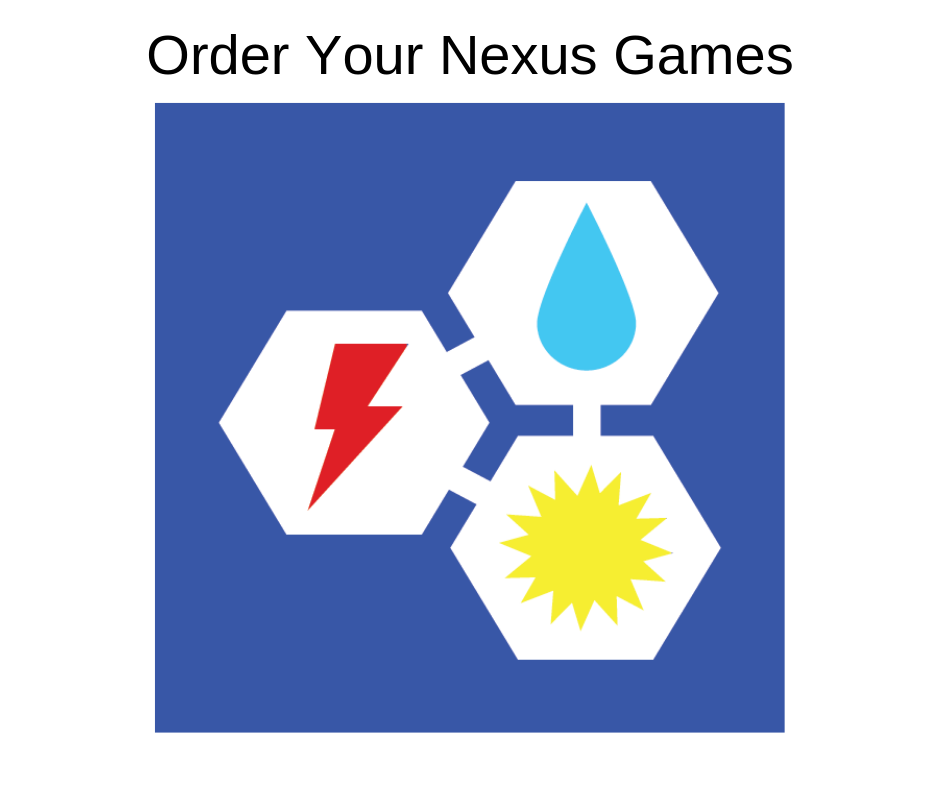
Thirst for Power is a fun and challenging game in which players explore how energy demand, consumption of water resources, and climate are tightly intertwined.
How are they intertwined?
All processes for generating energy use water, for some processes enormous quantities. It takes water to get energy. The inverse is also true: it takes energy to get water. It takes energy to move water from where it is stored to where it is needed.
All processes for generating energy have some form of environmental impact; in this game, we are most interested in impact climate. Our most common source of energy—burning of fossil fuels like coal, oil, and natural gas—gives off CO2and soot that warm our Earth. Thus energy generation impacts climate.
On the other hand, climate impacts both energy generation and water resources. Extreme weather brings droughts and water shortages, limiting energy generation.
Thus energy, water, and climate are highly inter-connected. A CHANGE IN ONE LINKS TO CHANGES IN THE OTHERS. This is the nexus of energy, water, and climate.
In this game, each player is the governor of a region of the country. The goal of the game is to fulfill your region’s transportation and general energy needs with available water exceeding your environmental impact limit. The environmental impact includes climate change, water and air pollution, and others. The first governor to be successful in meeting this challenge wins the game.

This is a card game for 2-5 players. GOAL cards show the GENERAL ENERGY and TRANSPORTATION ENERGY requirements for a specific region, as well as the environmental impact level (X) that a player cannot exceed and still win the game. They also specify a unique bonus to the region; for example, the unique bonus for the Southeast region is, “Earn an extra 10 TRANSPORTATION ENERGY units for each ALGAE BIOFUEL Source in this region.” A region must achieve goals for both GENERAL and TRANSPORTATION ENERGY.
WATER cards are used as currency to acquire ENERGY SOURCES. They may also be used to take advantage of technology advances or to acquire environmental impact credits. The WATER cards have values of 1 WATER unit or 5 WATER units.
ENERGY SOURCE cards let you generate energy from different sources by paying for it using WATER cards as currency.
TECHNOLOGY, POLICY, AND CLIMATE IMPACT cards are ACTION cards.
TECHNOLOGY cards offer new technologies that may increase energy efficiency or decrease the environmental impact of your energy sources.
POLICY cards establish new government regulations. You play a POLICY card against another player of your choice at any time.
CLIMATE IMPACT cards describe events due to climate change that affect a player’s ability to generate energy from specific sources.
Game Play
Separate each of the ENERGY SOURCE, ACTION, and GOAL decks and shuffle each deck. Separate the 1-WATER and 5-WATER cards into two decks. Each player is dealt 1 GOAL card, 2 1-WATER cards, and 2 ENERGY SOURCE cards face down. Your GOAL card is placed face up in front of you; the other cards are held in your hand. Place the remaining decks of ACTION, ENERGY SOURCE, 1-WATER and 5-WATER cards in the middle of the table.
Start the game by negotiating any trades of ENERGY SOURCE cards. Players may continue to trade cards throughout the game.
The player to the left of the dealer goes first; play then continues clockwise. At the start of a turn, draw the number of 1-WATER cards allotted on your GOAL card. Then draw an ACTION card to your hand without showing it.
If an ACTION card is a CLIMATE EVENT, place it face up and perform the required action. POLICY and TECHNOLOGY cards can be held in your hand until it is advantageous to trade or play them. TECHNOLOGY cards can be played only during your turn. POLICY cards can be played at any time.
Play a POLICY card against another player by placing it face up in front of the other player. The action required by the card must be taken immediately.
TECHNOLOGY cards benefit the player who holds them. Play a TECHNOLOGY card by placing it face up in front of you and following the instructions on the card.
Players may decline to play or trade a drawn POLICY or TECHNOLOGY card by placing it under the ACTION card deck.
Players may play any ENERGY SOURCE card they hold at any time. To play an ENERGY SOURCE card, place it face up in front of you with one or more water cards in a fanned out display beneath the ENERGY SOURCE.
Players may purchase additional ENERGY SOURCE cards by returning one 1-WATER card to the 1-WATER card deck for each.
[NOTE: The 5-WATER cards are included for convenience; a player with five 1-WATER cards in play may simply replace them with one 5-WATER card.]
Each ENERGY SOURCE card can produce three levels of energy; higher energy levels are achieved by adding WATER cards to the ENERGY SOURCE during any of your turns. Each energy level has an associated water requirement and level of environmental impact. Energy is not generated in between these levels. For example, if it takes 4 WATER cards to generate energy at level 1, and 6 WATER cards to generate energy at level 2, the total number of cards under the ENERGY SOURCE card at level 2 should be 6, not 10. To put an ENERGY SOURCE in play, you may place 1 WATER card beneath it, but until you have placed 4 WATER cards no energy is generated.
At then end of a turn, a player cannot be holding more than 5 cards. Players must discard excess cards to the bottom of the appropriate decks or put them in play on the table using WATER cards.
Players may not remove water from an ENERGY SOURCE except in two instances:
1) During your turn, you may “retire” an ENERGY SOURCE by placing it beneath the ENERGY SOURCE deck. Half of the water you invested is returned to you. 2) You may also remove a WATER card from an ENERGY SOURCE, if you are required to pay a penalty, but hold no WATER cards in your hand.
Trading: During any of your turns, you may offer to trade one of your played ENERGY SOURCE cards (and any WATER cards played on it) with that of another player.
The player that meets both GENERAL ENERGY and TRANSPORTATION ENERGY goals without exceeding the environmental impact limit X wins the game.
Credits
Science Education Solutions, Inc. is grateful for the generous funding from the National Science Foundation for this project under Grant No. ISE-1011086. Any opinions, findings, and conclusions or recommendations expressed in this game are those of the authors and do not necessarily reflect the views of the National Science Foundation.
The Development Team for this game was Scott Balaban (Scott Balaban Design LLC) and Michelle Hall, Michael Mayhew, and Nalisha Johnson (Science Education Solutions, Inc.).
Expert input was provided by an Advisory Committee: Terry Wallace, Cathy Wilson, Gordon Keating, Rajan Gupta, Manvendra Dubey, and Andrew Wolfsberg (Los Alamos National Laboratory), Vincent Tidwell and Beth Richards (Sandia National Laboratory), Suzy Gurton (Astronomical Society of the Pacific), Stephen Pompea (National Optical Astronomy Observatory), and Michael D’Antonio (PNM Resources).
The project Evaluator, Alexis Kaminsky (Kaminsky Consulting LLC), conducted a formal evaluation based on observed game play and focus groups.

VISIT OUR STORE https://www.isenm.org/shoP/
